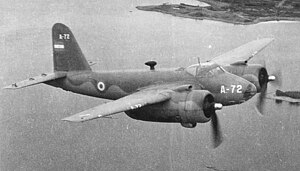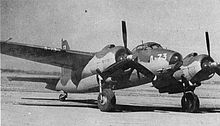avia.wikisort.org - Aeroplane
The I.Ae.24 Calquin (a Mapudungun word which means "Royal Eagle") was a tactical bomber designed and built by the Instituto Aerotécnico at Córdoba, in Argentina in the immediate post-World War II era. Although superficially a "look-alike" for the de Havilland Mosquito, the I.Ae.24 was powered by twin Pratt & Whitney R-1830-G “Twin Wasp” radials giving it a distinct appearance. After an operational career spanning two decades, the Calquin was retired.
| I.Ae. 24 Calquin | |
|---|---|
 | |
| I.Ae.24 Calquin in squadron use, c.1950[lower-alpha 1] | |
| Role | Light Bomber |
| Manufacturer | Fabrica Militar de Aviones (FMA) |
| Designer | Juan San Martin[1] |
| First flight | 4 July 1946 |
| Retired | 1960 |
| Primary user | Fuerza Aérea Argentina |
| Produced | 1947-1950 |
| Number built | 101 |
Design and development
Patterned after the successful de Havilland Mosquito, the Calquín had a wooden structure similar to the FMA AeMB.2, and was the first twin-engined aircraft designed and built in Argentina. The I.Ae.24 design was based on a cantilever mid-mounted wooden (indigenous woods were used throughout) wings with fabric-covered flying surfaces. The conventional main twin-oleo undercarriage retracted into the engine nacelles while the tailwheel retracted into the aft fuselage. The two-man crew were seated side by side under a large transparency constructed partly of acrylic glass with glass panels. The armament consisted of four 12.7 mm machine guns grouped in the nose. Some examples later had four 20 mm cannons and an internal bombload of 1,764 lb (800 kg) kg along with 12 rockets (75 mm) mounted under the wings.
Originally the I.Ae. 24 was also intended to be equipped with Rolls-Royce Merlins but an adequate supply of the powerplants was not possible, consequently Pratt & Whitney R-1830-G “Twin Wasp” radials of 1,050 hp (782.5 kW) were substituted. Performance estimates of a Merlin-powered variant would have made it comparable to the Mosquito but the R-1830-powered prototype was able to achieve only 273 mph (440 km/h), making the aircraft unstable and prone to stalling.[2] A later prototype, the I.Ae.28 was equipped with Rolls-Royce Merlins but the project was superseded by the more capable I.Ae. 30 "Ñancú".
Operational history
Despite the lower performance obtained in testing, the I.Ae.24 Calquin was able to undertake an attack and light bombing role, replacing the Northrop A-17 in the Argentine Air Force inventory. A total of 100 aircraft were ordered, with the first production example flying on 4 July 1946. Fifty pilots and crew members were killed in accidents related to Calquín operational service and trials. Test pilots considered the aircraft unstable "on all three axes" and required careful handling.[3] Series production was completed by 1950, with operational service continuing until 1957 although a small number of aircraft were still in squadron use until 1960.
Operators
 Argentina
Argentina
- Argentine Air Force
Variants
- I.Ae.24 "Calquín" "early"
- had 4 x 12.7 mm browning ML or DL nationally manufactured heavy machine guns along with "bomb" ordnance.

I.Ae.24 "Calquin"
- I.Ae.24 "Calquín" "late"
- had 4 x 20 mm Hispano-Suiza 804 automatic cannons along with "bomb" and "rocket" ordnance.

I.Ae.24 Late
- I.Ae.28 "Super Calquín"
- Evolved variant of the Calquin with Merlin engines and a look similar to the de Haviland "Mosquito", had a gunner and 4 - 6 x 20 mm cannons. Only a wooden mockup built. Led to the development of the I.Ae. 30 "Ñancú".

I.Ae. 28 Super Calquín fuselage
Specifications (I.Ae.24 "Calquín")
Data from Jane's all the World's Aircraft 1947,[4] Jane's Encyclopedia of Aviation[5]
General characteristics
- Crew: two: pilot, bombardier/navigator
- Length: 12 m (39 ft 4 in)
- Wingspan: 16.3 m (53 ft 6 in)
- Height: 3.4 m (11 ft 2 in)
- Gross weight: 6,500 kg (14,330 lb)
- Max takeoff weight: 7,200 kg (15,873 lb)
- Powerplant: 2 × Pratt & Whitney R-1830-SC-G Twin Wasp 14-cylinder air-cooled radial piston engines, 780 kW (1,050 hp) each
- Propellers: 3-bladed Hamilton Standard Hydromatic 23-E-50
Performance
- Maximum speed: 440 km/h (270 mph, 240 kn)
- Range: 1,040 km (650 mi, 560 nmi)
- Service ceiling: 10,000 m (33,000 ft)
- Wing loading: 170.9 kg/m2 (35.0 lb/sq ft)
- Power/mass: 4.13 kg/kW (6.8 lb/hp)
Armament
- Guns: *4× 12.7 mm browning ML or DL heavy machine guns nationally manufactured on the early variant
- or
- 4× 20 mm Hispano-Suiza 804 cannon with 300 rounds per gun on the later variant
- or
- 4× 20 mm Hispano Mk II cannon, 4× .303 in (7.7 mm) Browning machine guns
- Rockets: *12 x 75 mm 60 lb (27 kg) rockets (Mk VI) on the later variant
- Bombs: *800 kg (1,800 lb) bombs on both early and late variant
See also
- Comparable aircraft
Footnotes
- A-72 was the last surviving Calquin, used as an instructional airframe it survived into the 1960s, it was prepared for museum display but was destroyed around 1966
References
Notes
- Taylor and Alexander 1969, p. 42.
- Burzaco 1995, p. 65.
- Burzaco 1997, pp. 68–70.
- Bridgman, Leonard, ed. (1947). Jane's all the World's Aircraft 1947. London: Sampson Low, Marston & Co. pp. 3c–4c.
- Taylor 1980, p. 670.
Bibliography
- Burzaco, Ricardo. "I.Ae. 24 Calquin." Aeroespacio, Nro. 52, November–December 1997.
- Burzaco, Ricardo. Las Alas de Perón: Aeronaútica Argentina 1945/1960 (in Spanish). Buenos Aires: Ed. Da Vinci, 1995. ISBN 978-987-96764-4-8.
- Buttler, Tony (January–February 2005). "Argentine Twins: IAe 24 Calquin and IAe 30 Nancu". Air Enthusiast. No. 115. pp. 29–33. ISSN 0143-5450.
- Janes's All the World's Aircraft 1957-1958. London: Jane's All the World's Aircraft, 1958.
- Taylor, John W. R., and Jean Alexander. Combat Aircraft of the World. New York: G.P. Putnam's Sons, 1969. ISBN 0-71810-564-8.
- Taylor, Michael J.H. Janes's Encyclopedia of Aviation, Vol. 4. Danbury, Connecticut: Grolier Educational Corporation, 1980. ISBN 0-7106-0710-5.
Further reading
- Baldini, Atilio; Bontti, Sergio (2007). Núñez Padin, Jorge Felix (ed.). Instituto Aerotécnico I.Aé.-24 Calquin. Serie Fuerza Aérea Argentina (in Spanish). Vol. 13. Bahía Blanca, Argentina: Fuerzas Aeronavales. ISBN 978-987-20557-1-4.
External links
| Wikimedia Commons has media related to I.Ae. 24 Calquin. |
- I.Ae.24 "Calquin" (in Polish)
- I.Ae.24 "Calquin" (translated into English from Spanish)
- Aircraft history and specifications (in Spanish)
- Aircraft history, specifications and colour images (in Spanish)
- Pre-series testing by the "Grupo Experimental de Vuelo" (in Spanish)
На других языках
[de] FMA I.Ae. 24
Die FMA I.Ae. 24 Calquín war ein Jagdbomber des argentinischen Herstellers Fábrica Militar de Aviones.- [en] I.Ae. 24 Calquin
[ru] FMA I.Ae. 24 Calquín
ФМА I.Ae. 24 «Кальки́н» (исп. FMA I.Ae. 24 Calquín, «Королевский орёл») — аргентинский многоцелевой самолёт-бомбардировщик, состоявший на вооружении ВВС Аргентины. Построен на основе английского бомбардировщика de Havilland Mosquito. Первый двухмоторный ударный самолёт, спроектированный и произведённый в Аргентине и Латинской Америке[1][3].Другой контент может иметь иную лицензию. Перед использованием материалов сайта WikiSort.org внимательно изучите правила лицензирования конкретных элементов наполнения сайта.
WikiSort.org - проект по пересортировке и дополнению контента Википедии


